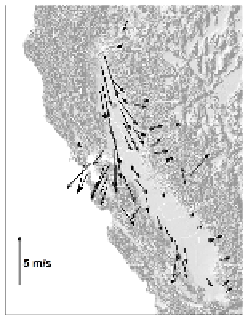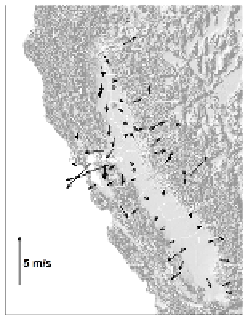Environmental Engineering Reference
In-Depth Information
Mismatches between observation- and simulation-based groupings can be used to
explore the relationship between CMAQ model performance for PM and biases in
the driving wind fields. This model validation approach is demonstrated for the
winter PM season in the San Francisco Bay Area (SFBA) of California, USA.
2. SFBA Study Domain and Summary of Previous Cluster
Analysis Results
SFBA is linked to Sacramento Valley (SV) and San Joaquin Valley (SJV) with
connections at the Delta of the San Francisco Bay (
Fig. 1)
. These basins share
similar air quality characteristics due to similar emissions, meteorology and terrain.
NAAQS 24-h PM
2.5
exceedances (>35 μg/m
3
) occur mostly during anticyclonic
weather conditions in December and January. Light, terrain-induced air flows
influence PM buildup, allowing ample time for secondary PM to form.
Sacramento
Valley
San Francisco
Bay Area
Delta
Pacific
Ocean
San Joaquin
Valley
R1
R2
Fig. 1.
Mean 1200 PST surface flow patterns for clusters R1 and R2. Arrow points along wind.
Geography indicated using dashed arrows for the R2 pattern
Clustering 1996-2007 SFBA winter surface wind measurements identified five
regional air flow patterns [2]. Three clusters (named R1, R2, and R3) are associated
with anticyclonic conditions and elevated PM levels. (“R” denotes upper-level
high pressure ridges.) R2 and R3 have weak large-scale pressure gradients, near calm
SV and SJV conditions and shallow, localized flows through SFBA. R2 exhibits
sustained SFBA easterly flows all day, whereas R3 SFBA flows may reverse to
westerly in the afternoon. Over 80% of SFBA PM
2.5
exceedances occur under R2,
and the rest are mostly under R3. R1 has a strong large-scale pressure gradient,
high winds entering SFBA from the east, moderate mixing depth and moderate
SFBA PM levels. Surface flows for R1 and R2 are shown in
Fig. 1.
Two other
clusters (V-ventilated; Z-zonal, often with precipitation) exhibit strong large-scale
pressure gradients, high SFBA westerly winds and low PM levels.



